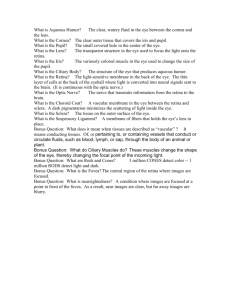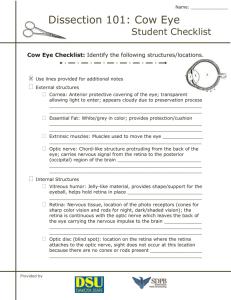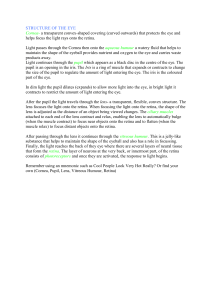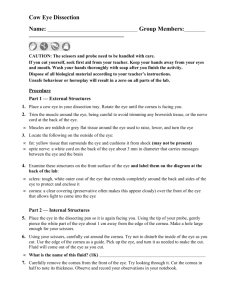The Special Senses
advertisement
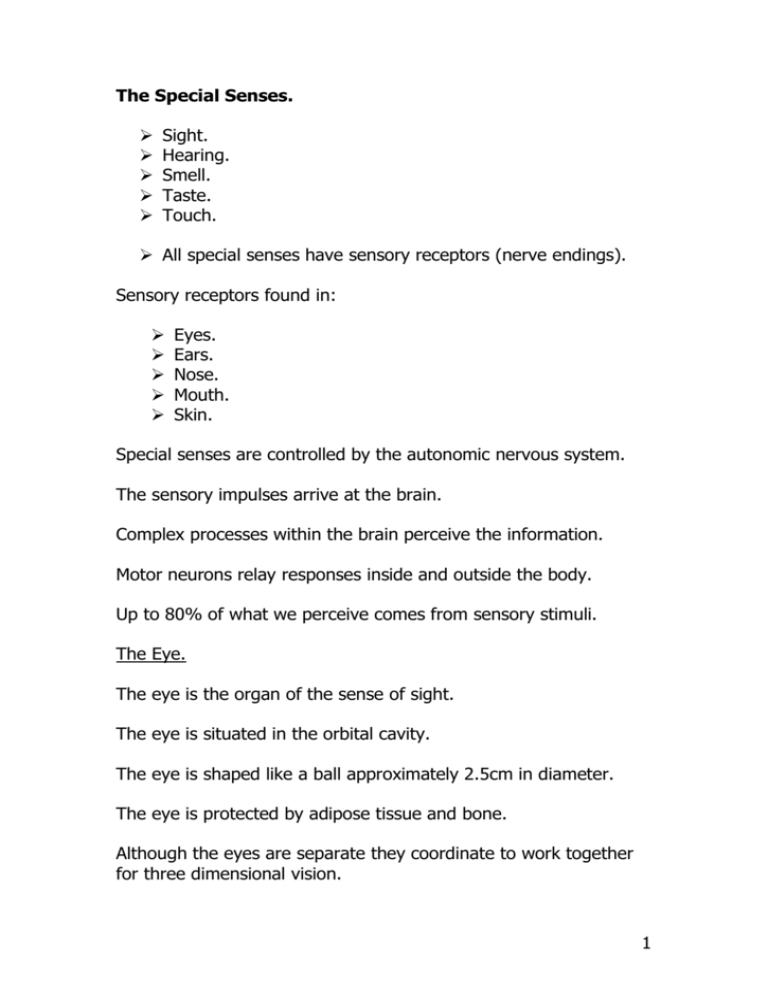
The Special Senses. Sight. Hearing. Smell. Taste. Touch. All special senses have sensory receptors (nerve endings). Sensory receptors found in: Eyes. Ears. Nose. Mouth. Skin. Special senses are controlled by the autonomic nervous system. The sensory impulses arrive at the brain. Complex processes within the brain perceive the information. Motor neurons relay responses inside and outside the body. Up to 80% of what we perceive comes from sensory stimuli. The Eye. The eye is the organ of the sense of sight. The eye is situated in the orbital cavity. The eye is shaped like a ball approximately 2.5cm in diameter. The eye is protected by adipose tissue and bone. Although the eyes are separate they coordinate to work together for three dimensional vision. 1 Structure of the Eye: Three layers of tissue in walls of the eye. Outer fibrous layer. - Sclera. - Cornea. Middle vascular layer. - Choroid. - Ciliary body. - Iris. - Lens. Inner nervous layer. - Retina. Outer Fibrous Layer. Sclera. White of the eye. Forms back and sides of eyeball. Fibrous tissue (strong to maintain form and shape of eye). Provides attachment for muscles. Cornea. Front of eye. Clear epithelial membrane. Light passes through cornea to get to retina. Cornea is convex and is involved in refraction (bending) of light rays to focus on the retina. Middle Vascular Layer. Choroid. Situated behind sclera. Rich in blood. Chocolate brown colour. Light enters through pupil stimulates nerve endings in retina. 2 Ciliary Body. Ciliary body is continuation of the choroid. Ciliary body is made of smooth muscle and secretory epithelial cells. One end provides attachment for suspensory ligament. Other end is attached to capsule that encloses the lens. Ciliary muscle changes thickness of the lens (this bends the light rays entering the eye to focus them on the retina). Epithelial cells secrete aqueous fluid into the anterior and posterior chambers (space between cornea and lens). The ciliary body is supplied by the parasympathetic oculomotor nerve. Stimulation of the occulormotor nerve causes contraction of the muscle and accommodation (focusing) of the eye. Iris. The iris lies behind the cornea and in front of the lens. It divides the anterior and posterior chambers. The lens is circular and composed of pigment (colour) cells and smooth muscle. The pupil is an aperture (hole) in the centre of the iris. The pupil varies in size depending on the intensity of light. - Bright light constricts pupil. - Dim light dilates pupil. Iris is supplied by sympathetic and parasympathetic nerves. - Sympathetic stimulation dilates the pupil. - Parasympathetic stimulation constricts the pupil. Albinos have no pigment cells. Blue eyes have fewer pigment cells than brown eyes. 3 Lens. Circular biconvex, transparent body. Suspended from Ciliary body by a ligament and enclosed within a capsule. Lens and capsule highly elastic. Lens is situated immediately behind pupil. Thickness controlled by ciliary muscle through the ligament. Retina. Delicate membrane composed of nerve fibres. Sensitive to light, having rods and cones. - Rods: black and white vision. - Cones: colour vision. Rods and cones are the sensory receptor cells. At the back of the there is a small depression called the macula (or yellow spot). In the centre of the macula is the fovea. Fovea is responsible for visual acuity (sharpness of vision). This is the most sensitive part of the eye. The optic nerve consists of all nerve fibres from the retina. Impulses are conducted along optic nerve to thalamus. The thalamus is the collecting, coordinating and selecting centre for sensory information. Information is then sent to the cerebral cortex. Where the optic nerve leaves the eye is known as the ‘blind spot’ as there are no light sensitive cells there. Accessory Organs of the Eye. The eye is a very delicate organ protected by several structures. Eyebrows. Eyelids. Conjunctiva (fine transparent membrane that lines the eyelids and front of eyeball). Lacrimal apparatus (tears). Tears contain water, antibacteriocidals, and oils. 4 Some Common Disorders of the Eye. Cateracts: Opacity of the lens, which may be age related, or congenital, bilateral or unilateral. Conjunctivitis: Inflammation of the conjunctiva may be caused by irritants such as dust, smoke, wind, cold or dry air, microbes. Glaucoma: Gradual painless rise in intraocular pressure with progressive loss of vision. Peripheral vision lost first, resulting in tunnel vision, resulting in blindness. May also cause sudden severe pain, photophobia (intolerance to light), loss of vision. Most common cause of preventable blindness. Macula Degeneration: Most common eye problem in >60s. Loss of central vision. Progressive destruction of rods, cones and connecting nerves. No cure. High dose vitamins may help. Injections controversial. Myopia (short sightedness): Optical power of the eye is too great for the eye. Corrected by glasses. Presbiopia (long sightedness): Aging of the eye. Loss of elasticity resulting in difficulty in reading. Corrected by glasses. Usually starts after the age of 40 years. Strabismus (squint, cross-eye): Eyes do not coordinate. Only one eye is directed at the image. Other diverges (directed elsewhere). Thus two images sent to brain, one from each eye. Caused by muscle weakness or nerve impairment. Usually image from squinting eye ignored by brain, otherwise there is diplopia (double vision). 5


